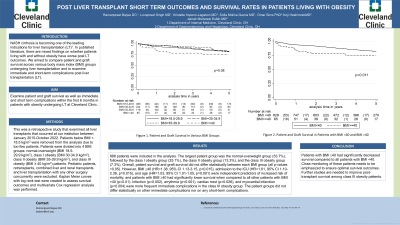Sunday Poster Session
Category: Liver
P0973 - Post Liver Transplant Short Term Outcomes and Survival Rates in Patients Living with Obesity
Sunday, October 22, 2023
3:30 PM - 7:00 PM PT
Location: Exhibit Hall

Has Audio
- RB
Ramanpreet Bajwa, DO
Cleveland Clinic Foundation
Shaker Heights, Ohio
Presenting Author(s)
Ramanpreet Bajwa, DO1, Lovepreet Singh, MD1, Kristelle Imperio-Lagabon, MD1, Sofia Molina Garcia, MD2, Omar Sims, PhD1, Koji Hashimoto, MD1, Jamak Modaresi, MD1
1Cleveland Clinic Foundation, Cleveland, OH; 2Cleveland Clinic, Cleveland, OH
Introduction: NASH cirrhosis is becoming one of the leading indications for liver transplantation (LT). In published literature, there are mixed findings on whether patients living with and without obesity have worse post LT outcomes. We aimed to compare patient and graft survival across various body mass index (BMI) groups undergoing liver transplantation and to examine immediate and short-term complications post liver transplantation (LT).
Methods: This was a retrospective study that examined all liver transplants that occurred at our institution between January 2015-October 2022. Patients below BMI < 18.5 kg/m2 were removed from the analysis due to too few patients. Patients were divided into 4 BMI groups: normal-overweight (BMI 18.5- 29.9 kg/m2), class I obesity (BMI 30-34.9 kg/m2), class II obesity (BMI 35-39.9 kg/m2), and class III obesity (BMI ≥ 40 kg/m2) patients. Pediatric patients, retransplants, combined liver and renal transplants and liver transplantation with any other surgery concurrently were excluded. Kaplan Meier curves with log rank test were created to assess survival outcomes and multivariate Cox regression analysis was performed
Results: 888 patients were included in the analysis. The largest patient group was the normal-overweight group (53.7%), followed by the class I obesity group (25.1%), the class II obesity group (13.3%), and the class III obesity group (7.3%). Overall, patient survival and graft survival did not differ statistically between each BMI group (all p-values >0.05). However, BMI ≥40 (HR=1.38, 95% CI 1.13-3.15, p=0.015), admission to the ICU (HR=1.61, 95% CI 1.10-2.36, p=0.015), and age (HR=1.03, 95% CI 1.01-1.05, p=0.001) were independent predictors of increased risk of mortality; and patients with BMI ≥40 had significantly lower survival when compared to all other patients with BMI < 40 (p=0.01). Infection (p=0.002), arrythmia (p< 0.001), cardiac arrest (p=0.026), and myocardial infarction (p=0.004) were more frequent immediate complications in the class III obesity group. The patient groups did not differ statistically on other immediate complications nor on any short-term complications.
Discussion: Patients with BMI ≥40 had significantly decreased survival compared to all patients with BMI < 40. Close monitoring of these patients needs to be emphasized to ensure optimal survival outcomes. Further studies are needed to improve post-transplant survival among class III obesity patients.
Disclosures:
Ramanpreet Bajwa, DO1, Lovepreet Singh, MD1, Kristelle Imperio-Lagabon, MD1, Sofia Molina Garcia, MD2, Omar Sims, PhD1, Koji Hashimoto, MD1, Jamak Modaresi, MD1. P0973 - Post Liver Transplant Short Term Outcomes and Survival Rates in Patients Living with Obesity, ACG 2023 Annual Scientific Meeting Abstracts. Vancouver, BC, Canada: American College of Gastroenterology.
1Cleveland Clinic Foundation, Cleveland, OH; 2Cleveland Clinic, Cleveland, OH
Introduction: NASH cirrhosis is becoming one of the leading indications for liver transplantation (LT). In published literature, there are mixed findings on whether patients living with and without obesity have worse post LT outcomes. We aimed to compare patient and graft survival across various body mass index (BMI) groups undergoing liver transplantation and to examine immediate and short-term complications post liver transplantation (LT).
Methods: This was a retrospective study that examined all liver transplants that occurred at our institution between January 2015-October 2022. Patients below BMI < 18.5 kg/m2 were removed from the analysis due to too few patients. Patients were divided into 4 BMI groups: normal-overweight (BMI 18.5- 29.9 kg/m2), class I obesity (BMI 30-34.9 kg/m2), class II obesity (BMI 35-39.9 kg/m2), and class III obesity (BMI ≥ 40 kg/m2) patients. Pediatric patients, retransplants, combined liver and renal transplants and liver transplantation with any other surgery concurrently were excluded. Kaplan Meier curves with log rank test were created to assess survival outcomes and multivariate Cox regression analysis was performed
Results: 888 patients were included in the analysis. The largest patient group was the normal-overweight group (53.7%), followed by the class I obesity group (25.1%), the class II obesity group (13.3%), and the class III obesity group (7.3%). Overall, patient survival and graft survival did not differ statistically between each BMI group (all p-values >0.05). However, BMI ≥40 (HR=1.38, 95% CI 1.13-3.15, p=0.015), admission to the ICU (HR=1.61, 95% CI 1.10-2.36, p=0.015), and age (HR=1.03, 95% CI 1.01-1.05, p=0.001) were independent predictors of increased risk of mortality; and patients with BMI ≥40 had significantly lower survival when compared to all other patients with BMI < 40 (p=0.01). Infection (p=0.002), arrythmia (p< 0.001), cardiac arrest (p=0.026), and myocardial infarction (p=0.004) were more frequent immediate complications in the class III obesity group. The patient groups did not differ statistically on other immediate complications nor on any short-term complications.
Discussion: Patients with BMI ≥40 had significantly decreased survival compared to all patients with BMI < 40. Close monitoring of these patients needs to be emphasized to ensure optimal survival outcomes. Further studies are needed to improve post-transplant survival among class III obesity patients.
Disclosures:
Ramanpreet Bajwa indicated no relevant financial relationships.
Lovepreet Singh indicated no relevant financial relationships.
Kristelle Imperio-Lagabon indicated no relevant financial relationships.
Sofia Molina Garcia indicated no relevant financial relationships.
Omar Sims indicated no relevant financial relationships.
Koji Hashimoto indicated no relevant financial relationships.
Jamak Modaresi indicated no relevant financial relationships.
Ramanpreet Bajwa, DO1, Lovepreet Singh, MD1, Kristelle Imperio-Lagabon, MD1, Sofia Molina Garcia, MD2, Omar Sims, PhD1, Koji Hashimoto, MD1, Jamak Modaresi, MD1. P0973 - Post Liver Transplant Short Term Outcomes and Survival Rates in Patients Living with Obesity, ACG 2023 Annual Scientific Meeting Abstracts. Vancouver, BC, Canada: American College of Gastroenterology.
